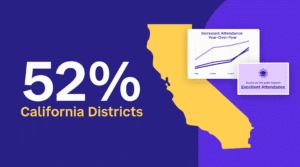
Featured Resource
Why Over Half of California School Districts Trust SchoolStatus
Read More >Join Mission: Attendance to reduce chronic absenteeism in 2025-26! >> Learn How <<



How to Choose the Best Attendance Management Solution for Your District
Including Downloadable Tools and Resources to Get You Started
Help your district convert data into action with targeted strategies and solutions to boost student attendance and engagement.
![[Guide] A 6-Step Guide to Choosing the Right Attendance Management Solution-feature-image-1200×675 Student raising had with graphs and metrics for attendance management solutions](https://www.schoolstatus.com/wp-content/uploads/Guide-A-6-Step-Guide-to-Choosing-the-Right-Attendance-Management-Solution-feature-image-1200x675-1-900x506.png)
Districts implementing automated attendance interventions and family-school communications solutions have reduced chronic absenteeism by up to 20% while improving family engagement, funding, and morale.
Chronic absenteeism isn’t just a student issue—it’s a systems issue. When students miss school, it impacts funding, staff morale, graduation rates, and lifelong outcomes.
This 6-step guide is your blueprint for making a strategic, confident decision. You’ll learn how to evaluate your needs, bring the right voices to the table, and choose a solution that empowers your educators, supports your families, and improves student outcomes.
Step 1: Assemble the Right Team
Step 2: Define Your Attendance Goals
Step 3: Explore Comprehensive Attendance Solutions
Step 4: Evaluate Stakeholder Experience
Step 5: Build a Strategic Implementation Plan
Step 6: Monitor, Measure, and Improve
Proving ROI: Real Impact in Real Districts
Real Results in Action
FAQs
![]()
Attendance success is a team sport. Your evaluation process should include representatives from every level of the district:
We’ve taken the attendance letter burden off schools and moved it to the district. SchoolStatus has made that process seamless.
AJ Philips, Prince William County Schools
Start with clarity. What do you want your attendance strategy to achieve?
Use baseline data to set measurable goals like:
Our ability to deliver targeted, data-driven, and effective messaging has increased our family engagement tremendously.
Matt Guilfoyle, CIO, Prince William County Schools
External Resource: Attendance Works – Data and Goal Setting
Not all platforms are created equal. Focus on features that empower action, not just recordkeeping.
Essential Features:
As an administrator, I no longer have to interpret multiple systems or rely on teachers for communication records.
Dana K., School Administrator
Featured Product: SchoolStatus Attend helps schools take early action and reduce administrative burden.
A platform that doesn’t serve your people won’t serve your purpose. Evaluate usability, inclusivity, and support.
Ask:
External Resource: National Center for Education Statistics (NCES)
Success isn’t just in what you buy—it’s in how you roll it out.
Checklist for Rollout:
Once your platform is in place, build a cycle of reflection.
Best Practices:
Truant parents were more responsive to getting letters mailed home. SchoolStatus Attend makes the process easier.
Terrance Dunn, Principal, Newark USD
External Resource: Edutopia – Strategies for Improving Attendance
Choosing a powerful attendance solution isn’t just a strategic move—it’s a financial one.
Attendance influences more than just student achievement. Many states tie funding directly to average daily attendance, so each intervention and improvement counts.
Here are some example ROI Metrics to Track:
Check out this Attendance Impact Calculator to see the positive effect higher attendance rates could have on your district.
Roseville City School District in California tackled rising chronic absenteeism by partnering with SchoolStatus Attend to implement a data-driven, proactive approach to family communication. Transitioning from manual attendance tracking to real-time data access, the district empowered educators to identify and address attendance issues promptly. This shift enabled consistent, district-wide protocols and the launch of the “Every Day Matters” campaign, fostering positive messaging about attendance across various platforms. Read the blog post to learn more!
The most notable outcome was a 43% average reduction in chronic absenteeism across all 21 school sites by the end of the 2023–2024 school year. As of January 2025, the district maintained a 34.71% decrease in chronic absenteeism, with significant improvements among English Language Learners, whose absenteeism rates dropped from 13% to 7%.
Erin Peterson, Director of Educational Services, highlighted the district’s success:
Our coherent and focused messaging, conferences to partner with families, community and proactive outreach, and targeted campaign is showing its effectiveness to support students and families with coming to school.
Download the complete case study.
Troup County School System in Georgia faced inconsistent attendance tracking and communication across its 18 schools. To address this, the district implemented SchoolStatus Attend, an automated attendance management platform. This solution streamlined processes by automating parent notifications and providing real-time visibility into student attendance, enabling staff to focus on strategic interventions rather than administrative tasks.
As a result, the district achieved a 25% reduction in chronic absenteeism over two years, decreasing from 16.6% in 2022–23 to 12.2% in 2024–25. The platform also facilitated over 9,500 attendance-related communications and 1,800 documented family meetings, improving student attendance.
Candice McGhee, Director of Preventions and Interventions, highlighted the platform’s impact:
We don’t have to worry about [letters] anymore, SchoolStatus Attend does that for you—and that’s time management as well, so that’s something else that the school officials could be working on instead of trying to get letters together.
Download the complete case study.
Grand Prairie Independent School District (GPISD), serving over 26,000 students across 39 schools in Texas, faced challenges with outdated attendance tracking methods that hindered timely interventions. The manual processes consumed valuable time, making it difficult for the district’s small attendance team to focus on direct student support. To address this, GPISD implemented SchoolStatus Attend, a platform designed to streamline attendance management and facilitate proactive communication with families.
Since adopting SchoolStatus Attend, GPISD has enhanced its real-time monitoring of attendance data, allowing for quicker identification of at-risk students and more effective interventions. The platform’s automation capabilities have reduced administrative burdens, enabling staff to dedicate more time engaging with students and families. Notably, the district achieved a 23% conference effectiveness rate, indicating that nearly a quarter of students showed improved attendance following intervention meetings.
Dr. Tameka Lewis, GPISD’s Student Attendance & Dropout Prevention Coordinator, emphasized the impact of the new system:
The process prior to SchoolStatus Attend was time-consuming and cumbersome. Because of the endless cycle of paperwork, there was a lot less people work going on.
Download the complete case study
At SchoolStatus, we believe that every student deserves the best chance to succeed—and that starts with being present. Our integrated platform supports educators, administrators, and families by breaking down the barriers that keep students out of the classroom.
We combine SIS-integrated attendance data with intuitive dashboards, proactive communication tools, and automated outreach strategies to help districts spot patterns, intervene early, and drive lasting improvement.
With SchoolStatus, you get:
When you partner with SchoolStatus, you’re empowering your district with the clarity, consistency, and compassion needed to help every student show up and succeed. If you’re ready to discuss how your district can drive real results, schedule a call today.
Look for systems that offer:
These features ensure staff can act early and families stay informed.
Many states tie funding to average daily attendance (ADA). Chronic absenteeism can result in significant losses, often hundreds of thousands of dollars annually. See how much your district could save >
Yes. SchoolStatus is designed for seamless integration with major SIS platforms to maintain accuracy and reduce manual reporting.
Our team builds a custom rollout plan, including:
On average, 54% of students return to school after just one intervention. Many districts report increased family response rates and reduced absenteeism within the first semester. Full-scale improvements often follow within two cycles.
Ready to learn more about our suite of solutions?
